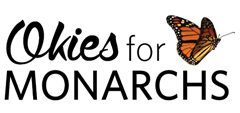Introduction
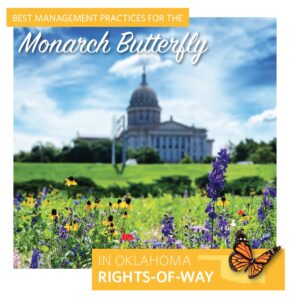 Authored By the Rights-of-Way Work Group of the Oklahoma Monarch and Pollinator Collaborative
Authored By the Rights-of-Way Work Group of the Oklahoma Monarch and Pollinator Collaborative
This document provides recommended Best Management Practices for monarch habitat on Oklahoma Industry Sector Rights-of-Way (ROW). These industries include but are not limited to:
a) Transportation ROWs
b) Electric Transmission ROWs
c) Photovoltaic Power Stations (Solar Parks)
d) Oil and Gas Distribution Lines
e) Rail Corridors
This document discusses Best Management Practices (BMPs) as suggested guidelines and are designed to be optional and applicable dependent upon industry regulatory restrictions and safety constraints.
Best Management Practices for the Monarch Butterfly in Oklahoma Rights-of-Way
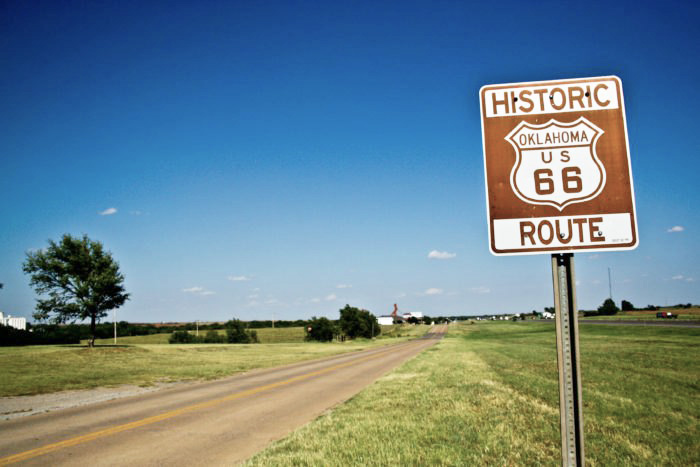 Roadway and railway transportation networks consist of interstates, highways, local roads, and railroads located in both suburban and rural landscapes. Monarch butterflies will inevitably cross many miles of these managed roadsides and rights-of-way throughout their migratory journeys. Transportation lands represent a wealth of diverse habitat communities that can provide valuable wildlife habitat to species such as monarch butterflies and other pollinators.
Roadway and railway transportation networks consist of interstates, highways, local roads, and railroads located in both suburban and rural landscapes. Monarch butterflies will inevitably cross many miles of these managed roadsides and rights-of-way throughout their migratory journeys. Transportation lands represent a wealth of diverse habitat communities that can provide valuable wildlife habitat to species such as monarch butterflies and other pollinators.
Access-Controlled Roadways (Interstates and Tollways)
Routinely mowed areas range from 15 to 30-feet adjacent to pavement and/or gravel shoulders (clear zone), are maintained by mowing and occasional herbicide use to provide for the safety of the motoring public.
The clear zone is not generally considered suitable habitat for monarchs. Sometimes the right-of-way is wide enough that suitable area for high quality habitat exists outside the clear zone to the control access fence. Additionally, some very wide medians allow for portions of the median to be high quality habitat as well as interchange infields. These high quality areas receive considerably less mowing or occasionally no mowing but are seldom left non-maintained due to the persistent attack of invasive plant species which would degrade the habitat.
Areas inside access control limits are generally protected from mowing and disturbances outside of authorized personnel. Due to their protected nature, these areas offer the highest value habitat within the highway transportation system when properly managed.
Highways (U.S. or State Marked Routes)
U.S. and state highways also maintain clear zones free from obstructions adjacent to pavement to allow motor vehicles to recover if they leave the pavement. These areas are not generally considered suitable habitat for monarchs, however areas that extend from the clear zone to the right-of-way boundary do offer potential habitat. These locations can be signed to identify the asset and to prohibit mowing or spraying during sensitive Monarch migration periods.
County and Local Roadways
These roads include county, township, or other roads not designated as an interstate, U.S., or state marked route, nor a municipal road (within the urban boundary or city limits). The right-of-way width varies significantly but is often between 30 to 75-feet in total width, including both pavement and shoulders. These rights-of-way can be managed by a county, municipality (township, village, city), or their contractors and can offer high quality habitat.
Transportation Parcels
In addition to roadsides, ODOT also maintains other land parcels that can benefit monarchs. Rest areas, storage and maintenance facilities, and wetland or other mitigation sites present potential for suitable habitat that can be enhanced for the benefit or monarchs. These areas provide opportunities for restoring natural vegetation or enhancing existing areas of natural vegetation to provide habitat. They may be highly visible to the public, such as rest areas along roadsides, which are great locations for possible monarch butterfly waystation plantings and have great potential for public involvement and outreach. These areas may have large tracts of land with habitat potential where the public can park without the safety concerns of the roadway. Other lands may have conservation potential, but are less visible, such as excess undeveloped land previously purchased for building or future rights-of-way development, picnic areas, and some mitigation sites.
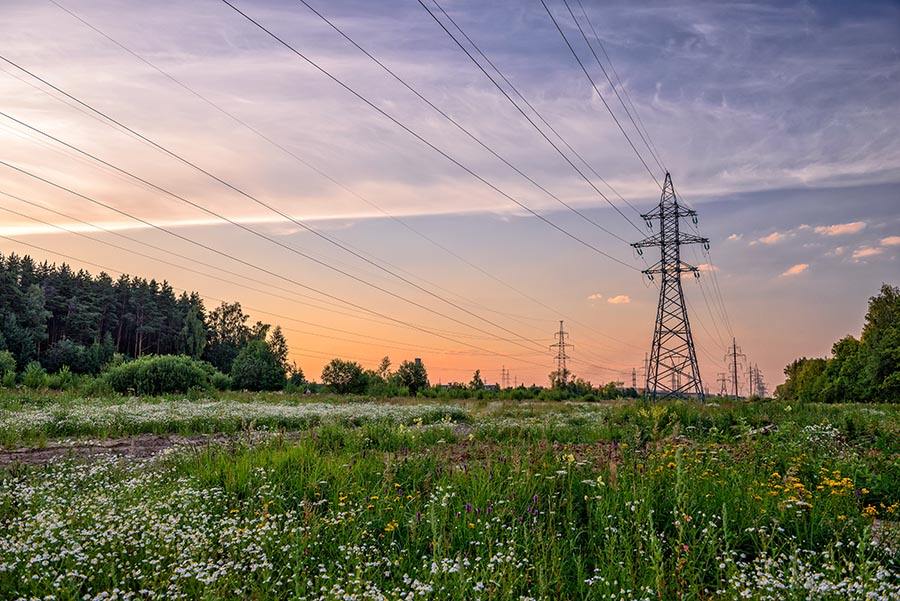 New Projects
New Projects
Provide guidance on how to restore and plant vegetation within a new easement using agreed upon seed mixes that would benefit the monarch butterfly and pollinators for different ecoregions in Oklahoma.
- Seed mixes need to be appropriate for the geography and site conditions, cost effective, and viable during all seasons of the year.
- Transmission lines may be able to recover without additional seeding through the native seed bank.
- Stations that have undergone significant soil modification during the construction process may require a more aggressive seeding plan, however, this provides the opportunity to include pollinator friendly seed mixes on a utility owned property.
Existing Rights-Of-Way
Maintenance of the ROW must comply with National Rural Electric Cooperative standards while meeting all environmental requirements. Companies should consider implementing integrated vegetation management (IVM) to maintain and/or enhance pollinator habitat within existing ROWs.
IVM practices reduce, but not eliminate, the need for pesticides and herbicides (a pesticide that kills plants) that promote healthy ecosystems, and provide measurable results, such as greater natural species diversity along rights-of-way and better control of invasive species. Control options for IVM may include techniques such as:
- biological
- chemical (Pesticide)
- cultural
- manual
- mechanical
- controlled burning (in some cases).
The desired outcome of IVM around utility rights-of-way is the development of shrub, forb or grassy areas that do not interfere with overhead power lines, pose a fire hazard, or hamper access.
Implementation of an IVM program is generally a multi-year process and can vary from region to region. The following is a general example of an IVM program:
- Year 1 – Mow ROW to remove tall vegetation and cut any trees that cannot be removed via mowing.
- Year 2 – Only use selective spot-treatment of woody vegetation when using a chemical herbicide
- Year 3 – Selectively treat woody vegetation and any unwanted vegetation with a chemical herbicide. Once control of woody vegetation has been achieved the program enters the maintenance stage. During this stage the ROW will be monitored to determine which selective treatments are needed. This is also a good opportunity to evaluate the general habitat and plant diversity within the ROW.
Education & Outreach
- Provide annual education to ROW contractors, internal forestry personnel, including ROW land agents, and project managers/engineers.
- Allow ROW agents to provide information and options to landowners regarding potential to restore the ROW with monarch and pollinator-friendly vegetation.
- Create and disseminate a brochure that a utility company could use to show a landowner about various opportunities for using approved seed mixes for monarchs and pollinators on their ROW.
- Coordinate with agricultural service providers (1,2) working with conservation programs to educate ROW owners with agricultural land about monarch and pollinator habitat cost share opportunities.
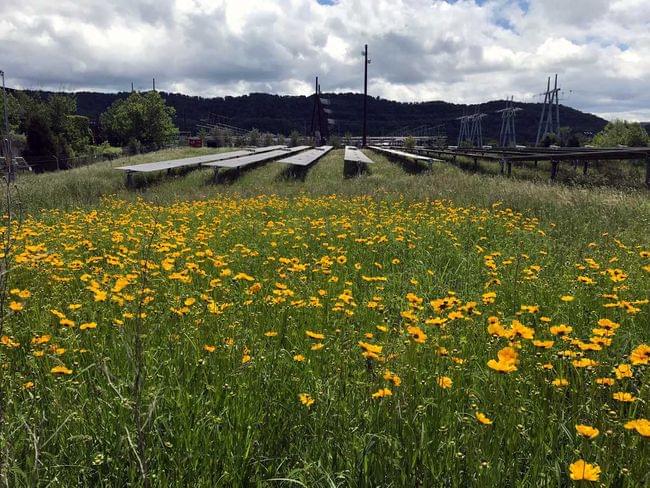
Solar facilities generally consist of open areas ranging from 5 to over 100 acres in size. This provides an opportunity to generate “green” energy and restore portions of the site with pollinator friendly habitat.
Solar arrays require regular maintenance, therefore, access to the panels may be needed in the form of gravel roads. Additionally, small mammals should be deterred from living near the panels due to the concern of damaging wiring or other components. To discourage small mammals routine mowing or herbicide application may be required around the solar arrays and supporting structures. This practice may also protect the equipment from unintentional fires.
The areas around the perimeter of the facility, however, may provide an opportunity for establishing, enhancing, and/or maintaining pollinator friendly plants. When possible, these areas should be restored with native flowering plants. Proper site preparation will greatly
enhance the likelihood of success of establishing a viable pollinator plot. Although each site may require different preparation techniques, generally all unwanted/invasive
plant species should be eliminated prior to planting.
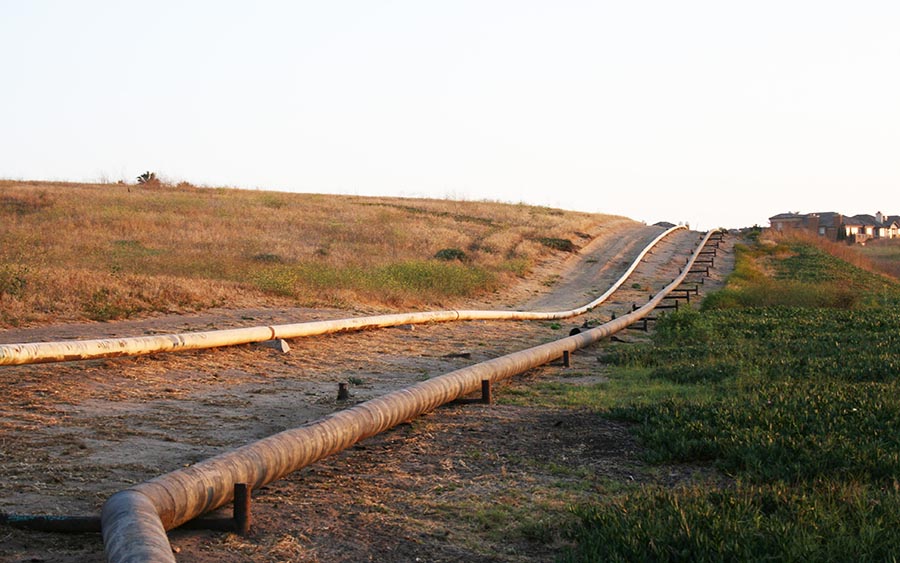 More than 2.6 million miles of pipeline exist within the United States. The average ROW for these pipelines is approximately 75 to 100 ft in width and can traverse portions of suitable monarch habitat. Maintaining vegetation along these ROWs are a constant challenge and takes time and operating budget. Federal pipeline integrity management rules require that activities be done along these ROW corridors with a clear path. These guidelines can be met by using Integrated Vegetative Management (IVM) techniques that will assist with
More than 2.6 million miles of pipeline exist within the United States. The average ROW for these pipelines is approximately 75 to 100 ft in width and can traverse portions of suitable monarch habitat. Maintaining vegetation along these ROWs are a constant challenge and takes time and operating budget. Federal pipeline integrity management rules require that activities be done along these ROW corridors with a clear path. These guidelines can be met by using Integrated Vegetative Management (IVM) techniques that will assist with
reducing costs as well as aid the conservation of monarch butterflies.
- Mechanical controls such as mowing, axe, and chainsaw clearing are usually where a program begins. Remember to treat freshly cut stumps within minutes with an approved herbicide to prevent woody plant regrowth.
- IVM can then be employed to manage a pipe zone-border zone where selective cutting and/or broadleaf herbicides maintain access paths over pipe routes and develop desirable plant communities.
- Herbicides prevent the regrowth of cut woody plants and allow compatible herbaceous plants to become established on the right of way.
- IVM encourages the successional establishment of native lowgrowing, stable grassy and broadleaf plant communities. As habitat matures it helps resist the re-establishment of woody plants and can eventually reduce the use of herbicides.
- IVM can be employed on both interstate pipelines and distribution systems to manage vegetation in a way that will facilitate inspections, testing, and general maintenance without having to constantly clear the vegetation.
- Once desirable vegetation is established in ROW corridors, they can be managed to promote native prairie, meadow and shrub habitats that are attractive to the community and provide food and shelter for a wide variety of birds, insects, and other wildlife.
 Much like highway rights-of-way, railroad rights-of-way generally consist of an area immediately adjacent to the track where vegetation is routinely managed through herbicide application to facilitate required inspections, decrease fire potential, maintain safe walking areas for train inspections, and provide visual clearance for motorists and pedestrians so they can safely view approaching trains.
Much like highway rights-of-way, railroad rights-of-way generally consist of an area immediately adjacent to the track where vegetation is routinely managed through herbicide application to facilitate required inspections, decrease fire potential, maintain safe walking areas for train inspections, and provide visual clearance for motorists and pedestrians so they can safely view approaching trains.
This area may only present minimal opportunity for monarch habitat. However, the remainder of rail rights-of-way beyond this area adjacent to the track are managed less frequently and therefore could serve as potential monarch habitat.
Current management includes occasional mowing, brush removal, and/or broadcast herbicide use. Adapting these measures through scheduled vegetation removal, or targeted herbicide treatments may offer potential improvements for monarch habitat.
Additionally, railroad companies often own non-operating properties, which consist of unused portions of rail yards abandoned railroad tracks, or other properties that are not currently in operation, which also pose opportunities for habitat conservation projects.
 Each site selected as potential monarch habitat, whether for restoration, enhancement, or new establishment will have its own unique challenges. A few general practices followed during the establishment phase will alleviate some of those challenges and ensure that projects have direct benefits for monarchs and other pollinators.
Each site selected as potential monarch habitat, whether for restoration, enhancement, or new establishment will have its own unique challenges. A few general practices followed during the establishment phase will alleviate some of those challenges and ensure that projects have direct benefits for monarchs and other pollinators.
- Conduct a site assessment and vegetative inventory to establish soil type, existing vegetation, drainage and slope needs, light conditions, and surrounding area land use. This will aid in directing site preparation and management activities.
- Identify invasive plant species and undesirable grasses and forbs and develop a plan to eliminate these from your site.
- Determine the purpose and need for your habitat project and identify vegetative species and planting methods (seeding or plugging) best suited to the site conditions.
- Plant diversity is key for monarch habitat and plantings should have at least three species that bloom in Spring, three species that bloom in summer, and three species that bloom during fall migration (late September to October 20).
- Timing for planting of native grasses and forbs will dictate the method and the success of habitat establishment or rehabilitation. i.e. Spring seeding is optimum conditions for grasses but many nectar plants will be delayed a year. Weed control will be required during this period. Fall seeding will need to be timed so that seeds stay dormant over winter and germinate the following spring. This is also a good time to interseed wildflowers in existing plantings. Snow/ice free winter seeding works well if the ground is bare or soil is tilled before the ground froze. Broadcasting directly on the soil is the preferred method for winter seeding and the cycle of thawing and freezing be allowed to work the seed into the substrate.
- Temporary seeding of non-invasive cover crops to stabilize soils during habitat creation can be done mid-March, April, July, and mid-October when it is not advisable to seed native plants.
- Sometimes the establishment of short-grass or intermediate height warm-season grasses is required first, with invasive grasses or invasive broadleaf removed through post-emergent broadleaf herbicide application. Then in year 2 or 3 diverse forb components can be introduced.
Maintaining Monarch Plantings in the first 24 months after planting
Proper site management of monarch and pollinator habitat is critical to project success, especially in the first 24 months. Implementing a consistent vegetative management schedule along with monitoring plant conditions to support native plants as well monarchs will ensure long-term benefits for the species.
- If undesirable vegetation begins to dominate the desired plant community, consider mowing the first summer after planting.
- Problem weeds should be hand-pulled, or spot sprayed with an appropriate herbicide. Post-emergent anti-grass herbicides can be used to reduce competition from non-native grasses while post emergent anti-broadleaf herbicides can be used to target invasive broadleaf plants.
- The second Summer after planting, mow 1 to 2 times (depending on site conditions) Set mower at 10” to 12” high and if needed spot mow a second time in areas of undesirable vegetation. Consider using grass-selective herbicides to reduce competition from grasses in small plantings.
- If conditions allow consider a burn in early summer (June 15 -July 15) to stimulate resprouting of green antelopehorn milkweed (Asclepias viridis) and spider milkweed (Asclepias asperula) in August and September.
Integrated Vegetative Management (IVM)
Proper site management of monarch and pollinator habitat is critical to project success, especially in the first 24 months. Implementing a consistent vegetative management schedule along with monitoring plant conditions to support native plants as well monarchs will ensure long-term benefits for the species.
IVM is defined as the process of promoting desirable, stable, low-growing plant communities that will resist the encroachment of undesirable weeds and woody vegetation by using environmentally sound and cost-effective control methods. These methods can include a combination of chemical, biological, cultural, mechanical, and/or manual treatments. By integrating management methods that can be implemented over seasonal plant life cycles the overall costs of maintenance can be reduced and desirable plant communities can be increased.
Methods within IVM programs promote:
- Herbicide use judiciously applied in a focused and selective manner.
- Reduced mechanical and manual controls.
- Introduction of specific plants or mulches to control vegetation growth and/or promote target plant communities.
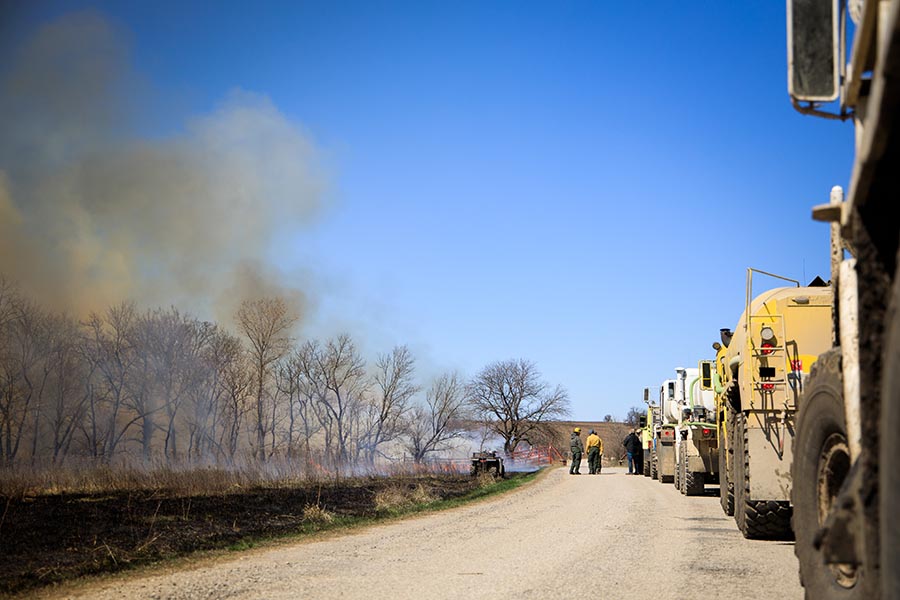
All of Oklahoma’s natural landscapes are fire-adapted. Prescribed fires can play a crucial role in the restoration of prairie habitats and nectar sources for Monarchs. While these fires positively affect the control of weeds and brush, their primary benefit lies in creating healthier ROW vegetation that is better able to perform such functions as soil stabilization, stormwater management, and resistance to weed invasion. Prescribed fires also provide auxiliary benefits such as improving the appearance of ROWs while maintaining habitat for native plants and wildlife such as monarchs.
- Burn grasslands and woodlands to create/maintain open conditions for monarchs, milkweeds, and nectar plants.
- If possible, avoid burning entire acreage at the same time. Split property into at least two burn units (preferably more), burning one unit each year or more than one unit at differing times in the same year, to create a patch-burn landscape.
- Vary the timing of your prescribed fires. Burn your units in different seasons to generate a variety of habitat conditions.
- Vary the timing of your prescribed fires. Burn your units in different seasons to generate a variety of habitat conditions.
- Burn in fall (late October - November) to stimulate flower production of spring-blooming nectar sources.
- Burn in early summer (June 15 - July 15) to stimulate resprouting of green antelopehorn (Asclepias viridis) and spider milkweed (Asclepias asperula) in August and September, and to maximize flower production of fall-blooming nectar sources.
- In areas with high milkweed density (>100 stems/ac), refrain from burning between April 1 – June 15 because monarch eggs, larvae and pupae are present on the landscape and are vulnerable to fire.
- Refrain from burning between August 1 and October 20th because monarch eggs, larvae and pupae are present on the landscape, vulnerable to fire, and because fire at this time will reduce the availability of fall nectar sources.
- If the property has few milkweeds and has a significant amount of exotic cool-season grass cover, burning in early summer (see above) when native warm season grasses such as big bluestem and Indiangrass are 1 to 2 inches tall will reduce cover of the exotic cool-season grasses.
- If the property has skips (unburned areas) within the burn units, leave them unburned. This is particularly important if burning when monarch eggs, larvae or pupae are present on the landscape, but is also important for pollinators other than monarchs.
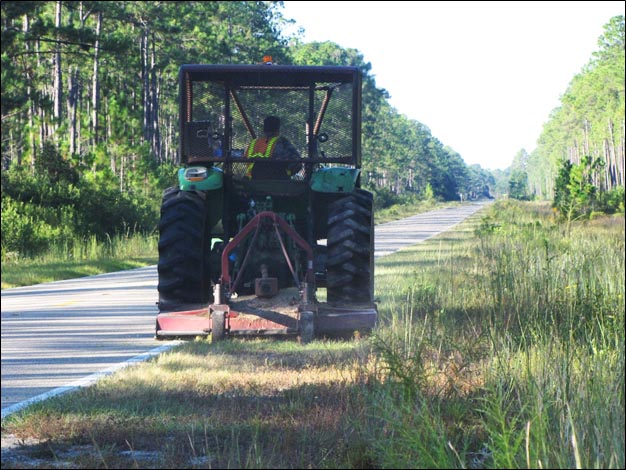
Habitat plantings specifically for Monarchs can benefit from mowing to control woody and weedy species and stimulate growth of desirable food, cover, and nectar plants for Monarchs and other pollinators. However, mowing too often or during species breeding and migration can result in high mortality and removal of critical Monarch habitat.
In order to provide the greatest benefit and limit detrimental impacts to Monarchs and other pollinators some standard recommendations can be applied:
- Once a site has become established, mowing frequency should be reduced, ideally not more than once per year (post-frost mowing) with a second-best program of mid-summer and post-frost mowing.
- Marking habitat areas may prevent accidental mowing, and signage helps communicate why an area is not mowed.
- Avoid mowing monarch habitat when monarchs are present. Mowing milkweed mid-summer in areas where there is a lull in monarch activity may promote milkweed growth and late summer or early fall breeding.
- Always mow after native plants finish blooming and dispersing seed. During the first year of some restoration projects (e.g., prairies), more frequent mowing may help with weed control.
- Use a minimum cutting height of 10-12 inches (shorter may be needed for early establishment mowing). This effectively removes seed producing parts of most invasive plants and minimizes habitat impact.
- Use a flushing bar and cut at reduced speeds to allow wildlife to escape prior to mowing.
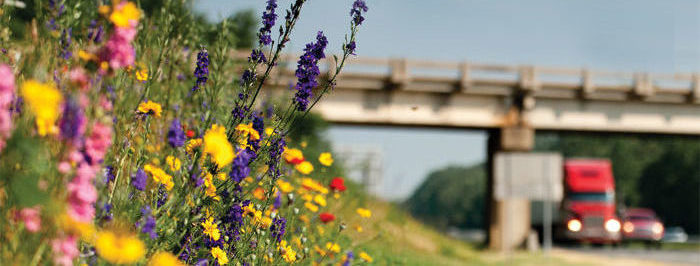
Guidelines that aim to protect pollinating species in managed ROWs rely on minimizing the use of herbicides to reduce impacts to Monarchs. A careful and efficient herbicide treatment regime can reduce damage to non-target plants and ensure pollinator resource needs. A judiciously applied herbicide regime may also reduce long-term maintenance costs by encouraging healthy stands of native vegetation and reduce the overall amount of herbicide needed.
Several herbaceous weed control steps should be incorporated in a treatment regime in order to get the most benefit. These steps include:
- Treat habitat areas in thirds to avoid the creation of monarch resource deserts.
- Use selective herbicides to control target undesirable plants.
- Use non-selective products on weeds when desirable native plants are dormant and only with directed or targeted applications.
- Attempt to use direct applications rather than broadcast spraying. Spot treatments made with a backpack sprayer or weed wiper and highly targeted spot-treatment applications to cut stems, stumps, or under bark can reduce unnecessary impacts to desirable plants.
- Treat weeds before they flower in order to better control of the weed and reduce the exposure of monarchs to herbicides.
- To reduce direct contact exposure to monarchs, apply herbicides during a time when they are less active or absent.
- When feasible avoid broadcast applications of systemic herbicides and herbicides with long residuals to reduce exposure to caterpillars that can be poisoned by consuming contaminated vegetation.
- Minimize risk of off target movement of herbicides through use of appropriate application equipment and techniques. Select products with reduce volatility during the summer months. Only apply herbicides when drift potential is minimal due to wind speed or temperature inversions.

There are three fundamental approaches to improving the quality of habitat for Monarchs and other pollinators: adjusting vegetation management strategies to accommodate life cycle resource needs, preserving existing optimum resources, and enhancing or restoring native vegetation along ROWs.
Whether the approach is for habitat creation, preservation, restoration, or enhancement, periodic monitoring will allow for adaptive management in order to contribute to the conservation of the species and the success of ROW projects.
Easy to use methods, such as photo point monitoring can illustrate change over time and provide valuable information to industry ROW managers. This can be as simple as setting permanent photo points, taking photos and returning the same time each year to repeat.
In addition to photo point monitoring there are some alternative assessment methods that can be used to quantify monarch/pollinator habitat. These assessment methods require more time and plant identification knowledge but can also be a great tool to illustrate the effectiveness of project methods. Several governmental, university, and non-profit organizations provide online resources and applications that can be designed to address basic to complex landscape monitoring needs. These applications can also aid with any regulatory monitoring requirements for species habitat.
- Energy Resources Center at the University of Illinois (Chicago) ROW as Habitat Working Group - The Pollinator Scorecard and Management Module.
- Monarch Joint Venture - Integrated Monarch Monitoring Program
- USDA-Natural Resources Conservation Service (NRCS) - Monarch Butterfly Wildlife Habitat Evaluation Guide - Southern Great Plains
- Xerces Center for Invertebrate Conservation - Xerces Pollinator Habitat Assessment Form and Guide
Monarch Best Management Practices Documents Reviewed
- EPA - Benefits of Integrated Vegetation Management (IVM) on Rights-of-Way. Pesticide Environmental Stewardship Program (PESP)
- EPA - Integrated Vegetative Management Fact Sheet
- Federal Highway Administration - Roadside Best Management Practices that Benefit Pollinators: Handbook for Supporting Pollinators through Roadside Maintenance and Landscape Design.
- Mid-America Monarch Conservation Strategy 2018-2038 v. 1.0 (MAMCS; MAFWA 2018)
- Minnesota Department of Transportation - Roadside Vegetative Management
- Monarch Joint Venture Mowing and Management - Best Practices for Monarchs
- Ohio Department of Transportation - Bee Pollinator Project
- USDA Conservation Fact Sheet, Integrated Vegetation Management (IVM) Maintenance Strategy for Improved Pollinator Habitat and Economic Benefits in Conservation Reserve Program Plantings. May 2017
- Thogmartin, W. E., L. Lopez-Hoffman, J. Rohweder, J. Diffendorfer, R. Drum, D. Semmens, S. Black. 2017a. Restoring monarch butterfly habitat in the Midwestern US: “all hands-on deck”. Environmental Research Letters. 12:074005
Additional Oklahoma Resources
Need Help Planting Seeds on Rights-of-Ways?
Did you know that the Oklahoma Department of Transportation provides assistance in planning and implementing roadside wildflower programs? They have drill seeders and loads of expertise!
